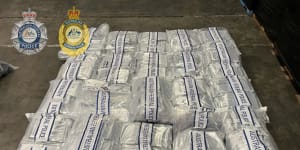About 3.69 tonnes of the drug with a potential street value of $1.4 billion was detected by law enforcement agencies in just six months to December – far more than in any 12-month period over the last decade,new data shows.
The Australian Border Force said the spike in seizures probably reflected global trends,where increased production in Colombia was seeing unusually large waves of cocaine smuggled to Europe and North America.

“I think the data would suggest that,yes,” said Kylie Rendina,the acting deputy commissioner for Australian Border Force (ABF) national operations. “The foreign law enforcement community has also observed this trend.”
Drug detections at the border have been rising for three years but the ABF data suggests a major new peak that appears to not be just an anomaly related to the COVID-19 pandemic.
The average amount of cocaine detected at borders over the past decade is 986 kilograms per year,and the previous peak for cocaine seizures was in 2020/21,when 2.57 tonnes of cocaine was detected as many customs officers were reassigned from COVID-closed airports to cargo inspection work.
The amount of amphetamine-type stimulants found by law enforcement agencies in the past six months was also historically high,with just under 5.2 tonnes found after 1045 separate seizures.
That compares to the ten-year average of 3.8 tonnes of amphetamines seized per year for the past decade,although seizures rose to a record of 7.3 tonnes in the financial year 2021/22,the data shows.
In part,the huge cocaine spike in seizures reflects several unusually large hauls - such as the 1.1 tonnes of the drug sent to Sydney labelled as rat poison and plastics in November.
But better co-operation with overseas law enforcement agencies also helped,as well as a higher tempo of operations compared with a decade ago,Rendina said.
“It’s enabled us to have more precise targeting effectiveness,” she said. “Our officer tradecraft and our targeting tradecraft has improved.”

Millions of dollars worth of cocaine and other drugs are intercepted while entering Australia every year.AFP
As well as drug seizures at the borders,illegal drug detections bound for Australia but intercepted offshore accounted for about 1.9 tonnes of border-controlled drugs and 8 tonnes of illicit tobacco.
While there have been several recent cases of syndicates using small boats to target remote areas of Australia’s coast,most smuggling and drug seizures took place at the major cargo ports in Sydney and Melbourne.
Drug syndicates have infiltrated ports and transport companies. It is understood that about 60 per cent of sea-based drug smuggling attempts involved “trusted insiders” - people who help drug traffickers by accessing international vessels and cargo before they are inspected and cleared by the ABF.
However,up to 80 per cent of drugs is believed to be evading border controls,an estimate supported by analysis of wastewater in 52 sites around Australia that indicates national drug use patterns.
The Australian Criminal Intelligence Commission,a national agency,said its research showed a high proportion of drugs were being seized but consumption levels remained roughly similar over the medium term.
“Serious and organised crime groups are resilient and will find ways to continually resupply drug markets,no matter the quantity of illicit drugs that are detected and seized,” an ACIC spokesperson said.
“ACIC analysis has found that law enforcement interventions disrupt supply for between two and six months in the case of large seizures,creating windows of opportunity in which efforts to reduce user demand may be more likely to succeed.”
The agency’s most recent report showed. New wastewater data that may show the effect of the recent high level of border seizures is set to be released later this month.
The NSW Bureau of Crime Statistics and Research said it had not seen a spike in crimes that are often linked to drug addiction,such as theft.
“We’ve seen general declines in crime associated with the pandemic,” said the bureau’s executive director Jackie Fitzgerald,citing new data released by BOCSAR this week.
“Robbery is still very low. Cocaine is in a different category of users though – cocaine users tend to be concentrated in the eastern suburbs and the Sydney CBD. It’s a different demographic that may not be fully reflected … in the police statistics.”
Spikes in drug use do not necessarily lead to an increase in property crimes,Fitzgerald said.
“Even when we saw the amphetamines spike a few years ago,we never actually saw that translate into an overall rise in criminal activity.”
The Morning Edition newsletter is our guide to the day’s most important and interesting stories,analysis and insights.Sign up.